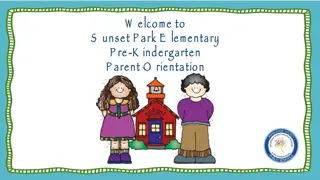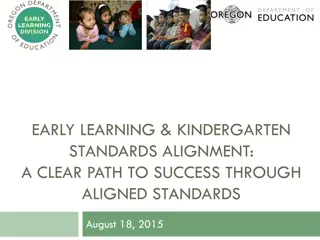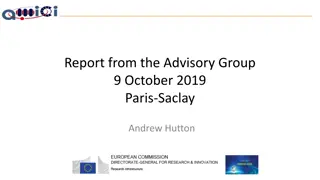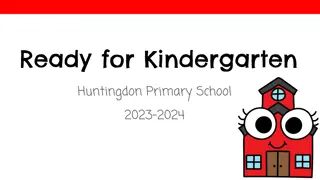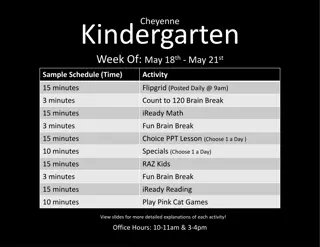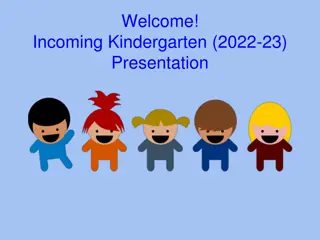State Superintendent's Advisory Committee on Four-Year-Old Kindergarten
State Superintendent's Advisory Committee on Four-Year-Old Kindergarten provides an overview of 4K enrollment, community approaches, program utilization, and opportunities for families in Wisconsin. It showcases the growth and access to early childhood education programs, including partnerships with child care facilities and private schools.
Download Presentation

Please find below an Image/Link to download the presentation.
The content on the website is provided AS IS for your information and personal use only. It may not be sold, licensed, or shared on other websites without obtaining consent from the author.If you encounter any issues during the download, it is possible that the publisher has removed the file from their server.
You are allowed to download the files provided on this website for personal or commercial use, subject to the condition that they are used lawfully. All files are the property of their respective owners.
The content on the website is provided AS IS for your information and personal use only. It may not be sold, licensed, or shared on other websites without obtaining consent from the author.
E N D
Presentation Transcript
State Superintendents Advisory Committee on Four-Year-Old Kindergarten
4K Overview 2015-2016 413 399 48,109 Children through 3rdFriday enrollment count (last year 48590) 8 New districts implementing 4K: Evansville Luxemburg-Casco Mequon-Thiensville Mukwonago Neenah Union Grove Waterford Winneconne 114 Districts report community approaches (program directory report) 14 Districts do not have 4K; of those 4 may start in 16-17 and 4 are looking at starting in 17-18 Total Public Elementary School Districts Total districts with 4K (last year 391)
4K Opportunities Opportunities to enroll in Four-Year-Old Kindergarten have never been higher. More families are utilizing those opportunities than ever before.
4K Opportunities More families utilize 4K programs every year. Utilization of Early Childhood Public Education by Cohort 50000 46901 44958 43470 45000 4K & KG 38867 40000 35000 30000 COUNT 23764 25000 KG Only 20765 18138 20000 15095 15000 10000 4534 4510 4K Only 4367 4010 5000 0 2012-2013 2013-2014 2014-2015 2015-2016 1ST GRADE COHORT
4K Opportunities: Community Approach Children bound for public school have greater access to a variety of 4K programs across the state. Children Bound for Public School by District 4K Availability 60 56.4 54.2 Community Approach 4K 49.6 47.6 50 42.8 40 41.2 39.2 PERCENT (%) School- Based 4K 30 30 20 13.6 11.2 7.6 4K 10 6.6 Unavailable 0 2010-2011 2011-2012 2012-2013 2013-2014 SCHOOL YEAR
4K Opportunities: Community Approach 1/5 districts contract with child care programs to offer 4K. Percentage of Districts 4K Community Approach Offerings (2015-16) 100 90 89.1 80 70 60 50 40 30 20 22.76 10 12.59 9.44 3.39 0.73 0 LEA Private Head Start Child Care Other None
4K Opportunities: Community Approach Private schools are the fastest growing 4KCA site. Change in Districts 4K Community Approach Offerings Since 2010-11 15 11.75 10 5 CHANGE IN PERCENT 5.1 -0.18 2.04 -1.2 0 LEA Private Head Start Child Care Other None -5 -10 -12.03 -15
4K Enrollments 4K students are more diverse than Wisconsin as a whole. Enrollment among economically disadvantaged students is higher than previously believed. Students with disabilities are increasingly integrated in traditional 4K classrooms. Annual 4K and KG Enrollments 70000 64235 63096 62631 62529 61996 KG 60000 51411 50129 49492 47837 50000 42877 4K 40000 COUNT 30000 20000 10000 0 2010-11 2011-12 2012-13 SCHOOL YEAR 2013-14 2014-15* * does not include Year End data.
4K Enrollments: Race Although Predominantly White, Wisconsin s 4K program is more diverse than the state as a whole. Enrollment by Race 90 80 70 2010-11 2011-12 2012-13 2013-14 2014-15* WI 2010 Census 60 50 PERCENT 40 30 20 10 0 American Indian Asian Black Hispanic (any Race) RACE Pacific Islander Two or More White * does not include Year End data.
4K Enrollment: Race Enrollment by race in proportion to Wisconsin s demography as of the 2010 Census. Rate of Enrollment by Race (2010-11 to 2014-15) 4 3.53 3.5 3 2.5 2.34 2.11 RATE 2 1.79 1.66 1.5 1.22 WI 2010 Census 1 0.82 0.5 0 American Indian Asian Black Hispanic (any Race) RACE Pacific Islander Two or More White
4K Enrollment: Poverty Economic status based upon Free and Reduced Lunch eligibility, as reported. Economic status of 2014-15 1st Grade Cohort by Grade 65 59.31 60 55 Not Economically Disadvantaged 52.5 51.3 50 PERCENT Economically Disadvantaged 47.5 48.7 45 40.69 40 35 30 4K KG 1st GRADE
4K Enrollment: Poverty Adjusted 4K economic status, lead one year when available. Adjusted Economic status of 2014-15 1st Grade Cohort by Grade 65 60 55 Not Economically Disadvantaged 52.5 51.3 50.59 Not Economically Disadvantaged 50 PERCENT 47.5 49.41 Economically Disadvantaged 48.7 45 Economically Disadvantaged This adjusted indicator is used in all subsequent measures of poverty 40 35 30 4K KG 1st GRADE
4K Enrollment: District Poverty Distribution of Enrollment by % of school population s adjusted FRL status. Enrollment by District Poverty Level 50 43.5 45 39.6 40 37 37 33.8 35 32 2010-11 2011-12 2012-13 2013-14 30.5 30 PERCENT 25 23.2 20 17.9 17.4 15.8 15.5 15.3 15.2 13.9 15 12.5 10 5 0 1st Quartile (Lowest Poverty Rate) 2nd Quartile 3rd Quartile 4th Quartile (Highest Poverty Rate) DISTRICT POVERTY LEVEL
4K Enrollment: Disability Status The distribution of four-year-olds by grade and disability status, as reported by the districts. Four-Year-Old Disability Status by Grade and Year 100 86.9 90 84.7 83.9 82.3 81 80 70 60 50 40 30 20 11.9 11.8 11.3 11.1 9.1 10 4.6 3.5 3.2 3.1 2.8 2.3 2.3 1.7 1.4 1.1 0 2010-11 2011-12 2012-13 2013-14 2014-15* Disabled PK Disabled 4K Non-Disabled 4K Non-Disabled PK (Reporting Error) * Does not include Year End data.
4K Enrollment: Disability Status Students with disabilities are increasingly enrolled in traditional 4K classrooms. Academic Setting of Disabled Four-Year- Olds (as Reported by Grade) 90 80 83.6 80.8 79.6 76.2 70 71.2 60 PERCENT (%) 50 40 30 28.8 20 23.8 20.4 19.2 16.4 10 0 2010-11 2011-12 2012-13 2013-14 2014-15* ACADEMIC YEAR * Does not include Year End data. Disabled PK (Segregated) Disabled 4K (Partially or Fully Integrated)
4K Attendance Attendance is relatively stable across academic years Attendance is highest among socio- economically privileged groups. Early Childhood Attendance 95.5 95 95 94.9 94.9 95 94.7 94.7 94.5 94.5 94 PERCENT 93.5 92.9 93 92.5 92 4K KG 91.5 2010-11 2011-12 2012-13 2013-14 SCHOOL YEAR
4K Attendance: Race Average attendance rates vary considerably across race Attendance Rates by Race (2010-11 to 2014-15) 96 95 95.3 94.3 (Mean) 94.4 94 94 93.7 93 92.9 92 PERCENT 91 90.8 90.3 90 89 88 87 Black American Indian Hispanic (any Race) Pacific Islander RACE Two or More Races Asian White
4K Attendance: Poverty Attendance Rate by Adjusted Economic Status Economically disadvantaged Students have a consistently lower attendance rate than non- economically disadvantaged students by a few absences per year. 97 96.4 96.2 Not Economically Disadvantaged 96 96 95 93.9 94 93.5 PERCENT 93.1 93 92.8 Economically Disadvantaged 92 91.9 91 90 89 2010-2011 2011-2012 2012-2013 2013-2014 SCHOOL YEAR
4K Attendance: Poverty This lower rate of attendance is driven by alternatively identified and free lunch students. Reduced lunch students are largely unaffected. Attendance by Adjusted Economic Indicator (2010-11 to 2013-14) 97 95.7 96 95.5 95 94.3 (Mean ) 94 93 92.5 PERCENT 92 91 90.4 90 89 88 87 Alternative Free Reduced Not Econ Disadvantaged ADJUSTED ECON INDICATOR
4K Attendance: District Poverty The most economically disadvantaged districts have a much lower rate of attendance. Attendance Rates by District Poverty Rate 96 95.4 95.4 95 94.6 94.3 (Mean) 94 93 PERCENT 92 91.1 91 90 89 88 1st Quartile (Least Disadvantaged) 2nd Quartile 3rd Quartile 4th Quartile (Most Disadvantaged) DISTRICT POVERTY LEVEL
4K Attendance: Disability Among students with disabilities, students with health issues are the most frequently absent. Average Attendance Rates by Disability (2010-11 to 2013-14) 95 94.4 94.3 94.3 (Mean) 94.2 94 93.5 93.2 92.9 93 92 92 91.3 91.2 91 90.3 90.3 89.7 90 89 88 87
4K Discipline Percent of Students with Disciplinary Incidents by Grade Suspension rates in 4K are considerably lower than in subsequent grades. Historically marginalized and disadvantaged groups are vastly over- represented in 4k disciplinary incidents Students with certain disabilities are more likely to be suspended. 9 8.5 8 7.6 High School 7 6.3 5.8 6 PERCENT (%) 5 5th Grade 4.3 4.3 4 3.8 3.4 3 2 1.5 1.4 KG 1.2 1.2 1 0.5 0.5 0.4 4K 0.3 0 2010-2011 2011-2012 2012-2013 2013-2014 SCHOOL YEAR
4K Discipline: Race The suspension rate of Black students far exceeds any other racial group. Percentage of Students Suspended by Race (2010-11 to 2013-14) 3.5 3 2.97 2.5 2 PERCENT 1.5 1 0.44 (Mean ) 0.5 0.31 0.06 0.21 0 Black Hispanic (any Race) Other White RACE
4K Discipline: Race This inequality is decreasing. Annual Rate of Suspended Students by Race (Holding White Students Constant) 80 69.1 70 Non-white students of all races are consistently more likely to be suspended than white students, however. 60 54.5 50 2010- 11 2011- 12 39.5 RATE 40 31.6 30 20 7.9 10 5 4.5 4.1 4 3.9 3 2.4 1 1 1 1 0 Black Hispanic (any Race) Other White RACE
4K Discipline: Race Racial inequalities in suspension rates diminish in higher grade levels, but are still present. Rate of Suspended Students by Grade and Race (Holding White Students Constant) (2010-11 to 2013-14) 60 50 49.1 40 Black Hispanic Other White RATE 30 20 10 12.3 10.8 2.4 1.3 1.8 1.8 1.9 1.7 4.9 1 1 1 4.6 1 3.4 0 4K KG 5th Grade High School GRADE
4K Discipline: Race Non-White students are also more likely to be suspended for a longer period than White students. Average Suspension Length by Race 1.8 1.61 1.6 1.51 1.34 1.4 AVERAGE DAYS SUSPENDED 1.14 1.2 1 0.8 0.6 0.4 0.2 0 Black Hispanic (any Race) Other White RACE
4K Discipline: Race Average Suspension Length by Grade and Race (2010-11 to 2013-14) The inequality in average length of suspension persists across grades, but evens out in high school. 4 3.7 3.5 3.5 3.5 3 3.1 AVERAGE DAYS SUSPENDED 2.5 Black Hispanic Other White 2 1.8 1.5 1.6 1.6 1.5 1.5 1.5 1.4 1.3 1.2 1 1.1 1 1 0.5 0 4K KG 5th Grade High School GRADE
4K Discipline: Poverty The vast majority of disciplinary incidents involve economically disadvantaged students Percentage of Suspended Students by Adjusted Economic Status 100 94.8 94.4 Economically Disadvantaged 90.7 89.4 90 80 70 60 PERCENT 50 40 30 20 10.6 9.3 5.6 10 5.2 Not Economically Disadvantaged 0 2010-2011 2011-2012 2012-2013 2013-2014 SCHOOL YEAR
4K Discipline: Poverty Students with reduced lunch are marginally affected compared to alternatively identified and free lunch students. Percentage of Students Suspended by Adjusted Economic Indicator 3.5 2.95 3 2.5 2 PERCENT 1.5 0.89 1 0.44 (Mean) 0.5 0.2 0.06 0 Alternative Free ADJUSTED ECON INDICATOR Reduced Not Disadvantaged
4K Discipline: Poverty Disciplinary incidents occur at a much higher rate in economically disadvantaged districts. Percentage of Students Suspended by District s Poverty Level (2010-11 to 2013-14) 3 2.43 2.5 2 PERCENT 1.5 1 0.5 0.44 (Mean) 0.08 0.06 0.04 0 1st Quartile (Lowest Poverty Rate) 2nd Quartile 3rd Quartile 4th Quartile (Highest Poverty Rate) DISTRICT POVERTY LEVEL
4K Discipline: Disability Suspension rates vary considerably across disability indicators. Percentage of Students Suspended by Disability Indicator 12 10.18 10 8 PERCENT 6 3.72 4 1.58 2 0.75 0.37 0.33 0.44 (Mean 0 Not Disabled ) Speech Language Hearing Significant Dev Delay DISABILITY Other Health Emotional Behavioral
4K Retention Retention functions differently in 4K than in subsequent grades, correlating with indicators of socioeconomic privilege. White students are twice as likely to receive two years of 4K than black students. Percentage of Students who Remain in the Same Grade the Following Year 3 2.5 2.4 4K 2 1.9 2 2 PERCENT KG 1.5 1.5 1.6 1.6 1.2 1 0.5 0 2010-11 2011-12 2012-13 2013-14* SCHOOL YEAR * Likely higher due to incomplete 2014-15 data
4K Retention: Race Retention in 4K is an opportunity far more likely to be extended to white students than non-white students. Percent of Students Retained by Race (2010-11 to 2013-14) 2.5 2.3 2 1.95 (Mean ) 2 1.5 1.3 1.3 PERCENT 1.1 1 0.9 0.9 0.5 0 Asian Pacific Islander Black Hispanic (any Race) RACE Two or More American Indian White
4K Retention: Poverty Alternatively identified economically disadvantaged students are particularly unlikely to be retained. Percent of Students Retained by Adjusted Economic Indicator 2.5 2.1 2 1.95 (Mean ) 2 1.8 PERCENT RETAINED 1.5 1 0.8 0.5 0 Alternative Free ADJUSTED ECON INDICATOR Reduced Not Econ Disadv
4K Retention: District Poverty The most economically disadvantaged districts are the least likely to retain their students. Percent of Students Retained by District Poverty Level (2010-11 to 2014-15) 2.5 2.3 1.95 (Mean ) 1.92 2 1.74 1.5 1.31 PERCENT 1 0.5 0 1st Quartile (Lowest Poverty Rate) 2nd Quartile 3rd Quartile 4th Quartile (Highest Poverty Rate) DISTRICT POVERTY LEVEL
4K Retention: Disability Students with any disability are far more likely to be retained than their non-disabled peers. Percentage of Students Retained by Disability Indicator (2010-11 to 2013-14) 30 25.8 25 20 PERCENT 15 12.7 9.7 10 8.2 8.2 7.4 7 6.4 5.4 5.3 4.3 5 1.95 (Mean) 1.2 0 DISABILITY
References R Core Team (2015). R: A language and environment for statistical computing. R Foundation for Statistical Computing, Vienna, Austria. www.R-project.org. United States Census Bureau (2010). Wisconsin Quick Facts, Race and Hispanic Origin. www.census.gov/quickfacts/ table/RHI125214/55,00. Wisconsin Department of Public Instruction (2015). Wisconsin Information System for Education (WISEdash) Database. dpi.wi.gov/wisedash.


